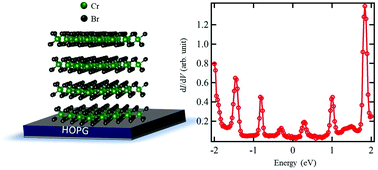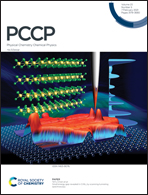Small energy gap revealed in CrBr3 by scanning tunneling spectroscopy†
Abstract
CrBr3 is a layered van der Waals material with magnetic ordering down to the 2D limit. For decades, based on optical measurements, it is believed that the energy gap of CrBr3 is in the range of 1.68–2.1 eV. However, controversial results have indicated that the band gap of CrBr3 is possibly smaller than that. An unambiguous determination of the energy gap is critical to the correct interpretations of the experimental results of CrBr3. Here, we present the scanning tunneling microscopy and spectroscopy (STM/S) results of CrBr3 thin and thick flakes exfoliated onto highly ordered pyrolytic graphite (HOPG) surfaces and density functional theory (DFT) calculations to reveal the small energy gap (peak-to-peak energy gap to be 0.57 ± 0.04 eV; or the onset signal energy gap to be 0.29 ± 0.05 eV from dI/dV spectra). Atomic resolution topography images show the defect-free crystal structure and the dI/dV spectra exhibit multiple peak features measured at 77 K. The conduction band – valence band peak pairs in the multi-peak dI/dV spectrum agree very well with all reported optical transitions. STM topography images of mono- and bi-layer CrBr3 flakes exhibit edge degradation due to short air exposure (∼15 min) during sample transfer. The unambiguously determined small energy gap settles the controversy and is the key in better understanding CrBr3 and similar materials.

- This article is part of the themed collection: 2021 PCCP HOT Articles


 Please wait while we load your content...
Please wait while we load your content...